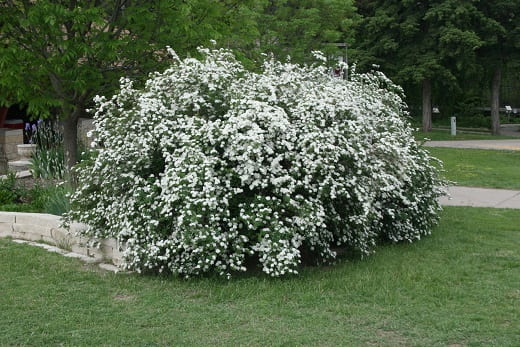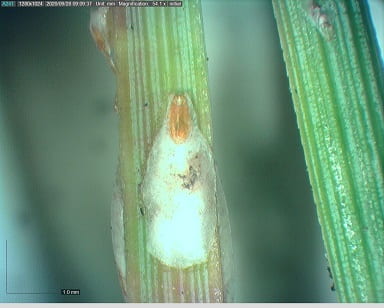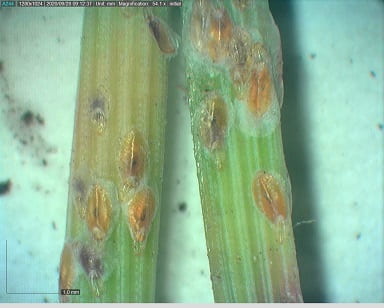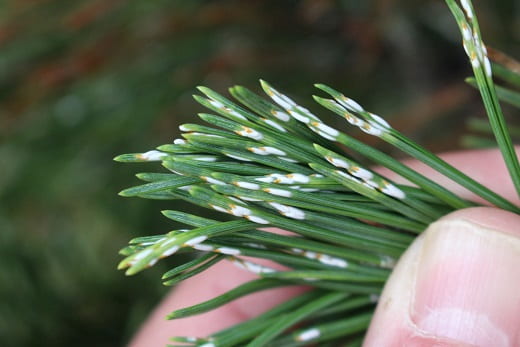–by Dr. Raymond Cloyd — Horticultural Entomology
Vanhoutte spirea, Spiraea x vanhouttei, plants are blooming (Figure 1), which means the first generation of pine needle scale, Chionaspis pinifoliae, nymphs (crawlers) are active and you need to “take action” now to prevent an infestation on pine trees or shrubs.
Figure 1. Vanhoutte spirea, Spiraea x vanhouttei, in full-bloom (Raymond Cloyd, KSU)
Biology
Pine needle scale females are approximately 1/8 inch (3.2 mm) long and white with an orange portion that tapers on one end (Figures 2 and 3). Males are 1/25 inch (1.0 mm) long and white with a rectangular covering. Males develop into winged individuals that mate with females and then die. Mated females produce a white, waxy covering, which provides protection from exposure to insecticide spray applications. Females lay (oviposit) red eggs underneath the protective covering and then die. Each female pine needle scale can produce up to 100 eggs.
Figure 2. Pine needle scale females on pine needles (Raymond Cloyd, KSU)
Figure 3. Close-up of pine needle scale female (Raymond Cloyd, KSU)
Red nymphs (crawlers) emerge (eclose) from the eggs and crawl out from under the dead female covering. First generation nymphs emerge over a two to three week period in spring and feed on the current or previous year’s pine needle growth. Second generation nymphs of pine needle scale emerge in summer. First-instar nymphs are flat and red, and after molting, second-instar nymphs are yellow to light-orange (Figure 4). After six to eight weeks, pine needle nymphs become mature adults. Pine needle scale nymphs may be dispersed by wind or carried by birds to new locations where the nymphs can infest other pine trees. In addition, pine needle scale nymphs may move onto branches of adjacent trees that are touching. Pine needle scale overwinters as red eggs underneath the covering of dead females. There are two generations per year in Kansas.
Figure 4. Pine needle scale nymphs (Raymond Cloyd, KSU)
Damage
Pine needle scales withdraw plant fluids from the inner tissues or mesophyll layer of pine needles using their piercing-sucking mouthparts. Feeding can cause pine needles to turn yellow and fall from trees. Pine needle scale infestations typically start on the lower branches. Pine needle scale feeding can reduce the growth and vigor of pine trees or shrubs in landscapes. Heavy infestations of mature pine needle scale appear as white flecks on needles (Figure 5). Since the pine needle scale is a hard or armored scale there is no honeydew, which is a clear, sticky liquid produced by soft scales.
Figure 5. Pine needle scales feeding on needles (Raymond Cloyd, KSU)
Management
Scout pine trees and shrubs weekly in spring to detect the presence of pine needle scale red nymphs. Double-sided sticky tape wrapped around branches captures red nymphs, which will help time insecticide applications or high-pressure water sprays. Check the tape weekly from spring through summer using a 10- to 16-power hand lens to look for the red nymphs. You can also attach a white sheet of paper to a clipboard and place under a branch that is shaken. Any red nymphs dislodged from the shaken branch may be seen crawling on the paper.
Branches heavily infested with pine needle scale should be pruned out and removed from the area. In addition, pine trees or shrubs in landscapes that are heavily infested with pine needle scale should be cut at the base, just above the soil line, and removed from the area.
High pressure water sprays can be used to dislodge (remove) the red nymphs from pine trees and shrubs, and are less harmful to beneficial insects. Pine needle scale nymphs do not have a waxy, protective covering, so they are easier to kill with contact insecticides. Contact insecticides such as horticultural oils (mineral-based) should be applied when the nymphs are active in spring and summer, which will help reduce pine needle scale infestations later in the growing season. Insecticide applications targeting the first-generation of nymphs should be made when Vanhoutte spirea, Spiraea x vanhouttei, plants are in flower…right now! Insecticide applications and high pressure water sprays should be conducted every seven to 10 days to kill or dislodge the nymphs that emerge from underneath the dead female covering over a two to three week period. Needles and branches should be thoroughly covered with insecticide applications or high pressure water sprays to effectively suppress pine needle scale populations. Pine needle scale is a hard or armored scale, therefore, systemic insecticides applied to the soil will not protect pine trees and shrubs from infestations.
For more information on pine needle scale, consult the following extension publication:
Cloyd, R. A. April 2021. Pine needle scale: insect pest of pine trees (MF3563)
https://www.bookstore.ksre.ksu.edu/pubs/MF3563.pdf




